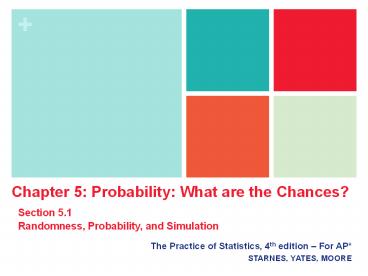The Practice of Statistics, 4th edition - PowerPoint PPT Presentation
1 / 10
Title:
The Practice of Statistics, 4th edition
Description:
Chapter 5: Probability: What are the Chances? Section 5.1 Randomness, Probability, and Simulation The Practice of Statistics, 4th edition For AP* – PowerPoint PPT presentation
Number of Views:114
Avg rating:3.0/5.0
Title: The Practice of Statistics, 4th edition
1
Chapter 5 Probability What are the Chances?
Section 5.1 Randomness, Probability, and
Simulation
- The Practice of Statistics, 4th edition For AP
- STARNES, YATES, MOORE
2
Chapter 5Probability What Are the Chances?
- 5.1 Randomness, Probability, and Simulation
- 5.2 Probability Rules
- 5.3 Conditional Probability and Independence
3
Section 5.1Randomness, Probability, and
Simulation
- Learning Objectives
- After this section, you should be able to
- DESCRIBE the idea of probability
- DESCRIBE myths about randomness
- DESIGN and PERFORM simulations
4
- The Idea of Probability
- Chance behavior is unpredictable in the short
run, but has a regular and predictable pattern in
the long run. - The law of large numbers says that if we observe
more and more repetitions of any chance process,
the proportion of times that a specific outcome
occurs approaches a single value.
- Randomness, Probability, and Simulation
Definition The probability of any outcome of a
chance process is a number between 0 (never
occurs) and 1(always occurs) that describes the
proportion of times the outcome would occur in a
very long series of repetitions.
5
- Myths about Randomness
- The idea of probability seems straightforward.
However, there are several myths of chance
behavior we must address.
- Randomness, Probability, and Simulation
The myth of short-run regularity The idea of
probability is that randomness is predictable in
the long run. Our intuition tries to tell us
random phenomena should also be predictable in
the short run. However, probability does not
allow us to make short-run predictions.
The myth of the law of averages Probability
tells us random behavior evens out in the long
run. Future outcomes are not affected by past
behavior. That is, past outcomes do not
influence the likelihood of individual outcomes
occurring in the future.
6
- Simulation
- The imitation of chance behavior, based on a
model that accurately reflects the situation, is
called a simulation.
- Randomness, Probability, and Simulation
Performing a Simulation
State What is the question of interest about
some chance process? Plan Describe how to use a
chance device to imitate one repetition of the
process. Explain clearly how to identify the
outcomes of the chance process and what variable
to measure. Do Perform many repetitions of the
simulation. Conclude Use the results of your
simulation to answer the question of interest.
We can use physical devices, random numbers (e.g.
Table D), and technology to perform simulations.
7
- Example Golden Ticket Parking Lottery
- Read the example on page 290.
- What is the probability that a fair lottery would
result in two winners from the AP Statistics
class?
Reading across row 139 in Table D, look at pairs
of digits until you see two different labels from
01-95. Record whether or not both winners are
members of the AP Statistics Class.
Students Labels
AP Statistics Class 01-28
Other 29-95
Skip numbers from 96-00 Skip numbers from 96-00
55 58 89 94 04 70 70 84 109843 56 35 69 34 48 39 45 17
X X X X ? X X X ?SkX X X X X X X X ?
No No No No No No No No No
19 12 975132 58 13 04 84 51 44 72 32 18 19 400036 002428
? ? SkXX X ? ? X X X X X ? ? XSkX Sk??
Yes No No No No No Yes No Yes
Based on 18 repetitions of our simulation, both
winners came from the AP Statistics class 3
times, so the probability is estimated as 16.67.
8
- Example NASCAR Cards and Cereal Boxes
- Read the example on page 291.
- What is the probability that it will take 23 or
more boxes to get a full set of 5 NASCAR
collectible cards?
Driver Label
Jeff Gordon 1
Dale Earnhardt, Jr. 2
Tony Stewart 3
Danica Patrick 4
Jimmie Johnson 5
Use randInt(1,5) to simulate buying one box of
cereal and looking at which card is inside. Keep
pressing Enter until we get all five of the
labels from 1 to 5. Record the number of boxes we
had to open.
3 5 2 1 5 2 3 5 4 9 boxes
4 3 5 3 5 1 1 1 5 3 1 5 4 5 2 15 boxes
5 5 5 2 4 1 2 1 5 3 10 boxes
We never had to buy more than 22 boxes to get the
full set of cards in 50 repetitions of our
simulation. Our estimate of the probability that
it takes 23 or more boxes to get a full set is
roughly 0.
9
Section 5.1Randomness, Probability, and
Simulation
- Summary
- In this section, we learned that
- A chance process has outcomes that we cannot
predict but have a regular distribution in many
distributions. - The law of large numbers says the proportion of
times that a particular outcome occurs in many
repetitions will approach a single number. - The long-term relative frequency of a chance
outcome is its probability between 0 (never
occurs) and 1 (always occurs). - Short-run regularity and the law of averages are
myths of probability. - A simulation is an imitation of chance behavior.
10
Looking Ahead































